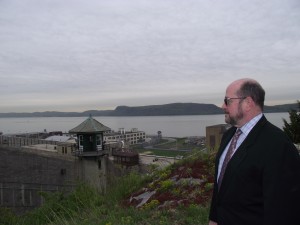
It could be the demolition project from hell on the Hudson if a quintet of elected officials has their revenue-dreaming wish for Ossining granted by New York”™s governor.
Flushed with his state budget victory, Gov. Andrew Cuomo in early April was asked by officials representing Ossining to close Sing Sing Correctional Facility, the state”™s 176-year-old maximum-security prison on the village waterfront. The request came in a letter delivered by Assemblywoman Sandra R. Galef, D-90th District, and signed too by state Sen. Suzi Oppenheimer, D-37th District, Westchester County Legislator William Burton and Ossining”™s Town Supervisor Catherine Borgia and Mayor William Hanauer.
One month later, Cuomo still has not issued his expected executive order closing several of the state”™s minimum-security and medium-security prisons to eliminate an excess capacity of at least 3,500 inmate beds at a projected savings of $72 million.
State Correctional Services Commissioner Brian Fischer in a May 2 letter to Galef said no decision has been made on the closings. That announcement is anxiously awaited by rural upstate communities that depend on state prisons for jobs.
Galef proposed that Cuomo spare an upstate prison and close Sing Sing instead. She said in an interview a medium-security prison could be converted to a maximum-security facility to replace Sing Sing “without too many difficulties.”
Privately, a state prison official said such a prison conversion has not been done in New York and is not likely. And none of the state”™s 17 maximum-security prisons are targeted for closing, he said.
Officials in their letter to the governor said the infamous Sing Sing sits on “55 to 60 of the most valuable and viable waterfront acres in the lower Hudson Valley.” The state would profit from the sale of all or part of the land and local municipalities would reap much-needed tax revenue from the property, they said.
Home construction or mixed-use development on the site and a planned Historic Sing Sing Museum that could be built there would provide hundreds of jobs and a tourist destination, officials said.
Of Sing Sing”™s 822 current employees, many correction officers are not permanent Ossining residents and send back their income and tax dollars to their home communities, the governor was told. The prison is no longer a major employer of local residents.
Hanauer, the Ossining mayor, said Sing Sing”™s location in a residential neighborhood has suppressed real estate values in the village. Closing and replacing it with a private development “would be a great boon to the community and all of Westchester,” he said. “That is a major reason why we want this. ”¦Certainly any landowner within a quarter of a mile of the prison feels that way.”
“Would it be wonderful if Sing Sing closed? Yes, it would be nice,” said commercial real estate broker Jerry Gershner, principal of Gershner Realty Services in Ossining.
Built to keep inmates within its walls, Sing Sing”™s formidably massive concrete and steel construction could keep out prospective developers if the prison were closed, Gershner said. “The cost of demolition and removal will vastly exceed the value of that property. The logistics of demolishing a prison on a constrained site has got to be mind-boggling.”
“Yes, it”™s a good property,” Gershner said. “The market”™s not ready for it anyway, but that”™s beside the point.”
In Ossining as in other Westchester communities, the market for redevelopment projects of the kind envisioned for the Sing Sing site has been largely moribund since the recession. Its waterfront remains a hodgepodge of warehouses and industrial buildings, oil storage tanks and small boat clubs.
To the north of the prison and adjacent to the village”™s Metro-North Railroad station, One Harbor Square, a heralded mixed-use development that was a joint venture of two of Westchester County”™s most prominent pre-recession developers, Cappelli Enterprises Inc. and Ginsburg Development Cos. L.L.C., stands only as signage on vacant lots after more than a decade of planning. Louis R. Cappelli, the original developer granted rights to the Harbor Square project in 1995, two years ago sought to pull out of the joint venture but was denied by village officials because of concerns over project insurance coverage.
Village officials have approved a site plan for the $78-million project that includes 150 market-rate condominiums and 10,000 square feet of retail and restaurant space on 4.5 acres, along with a public park, esplanade and recreational facilities on the river.
The Harbor Square developer has used the first of two extensions of development rights granted in the village”™s project agreement. Hanauer said village officials this spring will require Ginsburg to build a temporary park on the cleared site and improve the idle property”™s fencing and appearance and public access.
Farther north on the village”™s industrial waterfront, Plateau Associates L.L.C. is pursuing its application with the village for a luxury residential development on the 6-acre site of the former Brandreth Pill Factory, despite numerous obstacles and delays in the six years since the project was proposed. An estimated $80-million project, Hidden Cove on the Hudson will include 132 units.
“There are issues in play right now that we”™re trying to work out,” said Peter Stolatis, president of Plateau Associates in Pleasantville.
A past president of the Greater Ossining Chamber of Commerce, Stolatis has been a critic of village officials for failing to adequately promote the waterfront for residential redevelopment while allowing antiquated industrial operations to remain.
Regarding development, “There”™s absolutely nothing going on in the village,” Stolatis said. “I think it”™s actually a regressive situation down there. Whatever progress they may have made a few years ago has seemed to evaporate and disappear and nothing new is happening.”
On the waterfront, “We”™re the only players that I”™m aware of that are serious and have money in there that are trying to make this happen. It”™s not that easy with the village.”
















